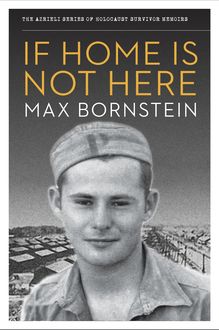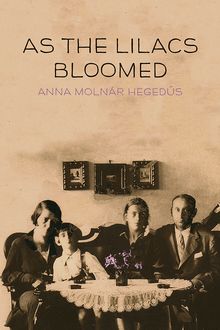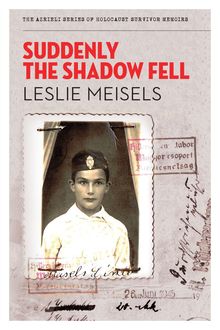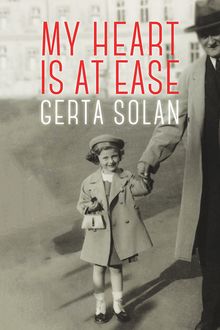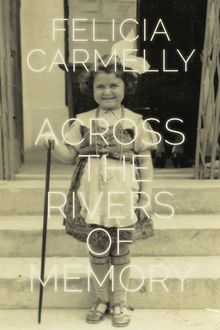-
 Univers
Univers
-
 Ebooks
Ebooks
-
 Livres audio
Livres audio
-
 Presse
Presse
-
 Podcasts
Podcasts
-
 BD
BD
-
 Documents
Documents
-
- Cours
- Révisions
- Ressources pédagogiques
- Sciences de l’éducation
- Manuels scolaires
- Langues
- Travaux de classe
- Annales de BEP
- Etudes supérieures
- Maternelle et primaire
- Fiches de lecture
- Orientation scolaire
- Méthodologie
- Corrigés de devoir
- Annales d’examens et concours
- Annales du bac
- Annales du brevet
- Rapports de stage
La lecture à portée de main
Vous pourrez modifier la taille du texte de cet ouvrage
Découvre YouScribe en t'inscrivant gratuitement
Je m'inscrisDécouvre YouScribe en t'inscrivant gratuitement
Je m'inscrisEn savoir plus
Vous pourrez modifier la taille du texte de cet ouvrage
En savoir plus

Description
Sujets
Informations
| Publié par | Azrieli Foundation |
| Date de parution | 01 septembre 2015 |
| Nombre de lectures | 1 |
| EAN13 | 9781897470954 |
| Langue | English |
| Poids de l'ouvrage | 1 Mo |
Informations légales : prix de location à la page 0,0300€. Cette information est donnée uniquement à titre indicatif conformément à la législation en vigueur.
Extrait
Where Courage Lives: They Called Me Marie
Muguette Szpajzer-Myers
The Azrieli Series of Holocaust Survivor Memoirs
Naomi Azrieli, Publisher
Jody Spiegel, Program Director
Arielle Berger, Managing Editor
Elizabeth Lasserre, Senior Editor, French-Language Editions
Farla Klaiman, Editor
Elin Beaumont, Senior Educational Outreach and Events Coordinator
Catherine Person, Educational Outreach and Events Coordinator, Quebec and French Canada
Marc-Olivier Cloutier, Educational Outreach and Events Assistant, Quebec and French Canada
Tim MacKay, Digital Platform Manager
Elizabeth Banks, Digital Asset and Archive Curator
Susan Roitman, Office Manager (Toronto)
Mary Mellas, Executive Assistant and Human Resources (Montreal)
Mark Goldstein, Art Director
François Blanc, Cartographer
Bruno Paradis, Layout, French-language editions
Contents
The Azrieli Series of Holocaust Survivor Memoirs
Series Preface: In their own words...
About the Glossary
Introduction
Map
In Memoriam
My Heritage
Without My Father
Living Quietly
Strange Things Happen
Rural Life
Seven Miracles
A Childhood in Champlost
Life Lessons
Return to Paris
Canada
Epilogue
Poems
Glossary
Photographs
Copyright
About the Azrieli Foundation
Also Available
Series Preface: In their own words...
In telling these stories, the writers have liberated themselves. For so many years we did not speak about it, even when we became free people living in a free society. Now, when at last we are writing about what happened to us in this dark period of history, knowing that our stories will be read and live on, it is possible for us to feel truly free. These unique historical documents put a face on what was lost, and allow readers to grasp the enormity of what happened to six million Jews – one story at a time.
David J. Azrieli, C.M., C.Q., M.Arch
Holocaust survivor and founder, The Azrieli Foundation
Since the end of World War II , over 30,000 Jewish Holocaust survivors have immigrated to Canada. Who they are, where they came from, what they experienced and how they built new lives for themselves and their families are important parts of our Canadian heritage. The Azrieli Foundation’s Holocaust Survivor Memoirs Program was established to preserve and share the memoirs written by those who survived the twentieth-century Nazi genocide of the Jews of Europe and later made their way to Canada. The program is guided by the conviction that each survivor of the Holocaust has a remarkable story to tell, and that such stories play an important role in education about tolerance and diversity.
Millions of individual stories are lost to us forever. By preserving the stories written by survivors and making them widely available to a broad audience, the Azrieli Foundation’s Holocaust Survivor Memoirs Program seeks to sustain the memory of all those who perished at the hands of hatred, abetted by indifference and apathy. The personal accounts of those who survived against all odds are as different as the people who wrote them, but all demonstrate the courage, strength, wit and luck that it took to prevail and survive in such terrible adversity. The memoirs are also moving tributes to people – strangers and friends – who risked their lives to help others, and who, through acts of kindness and decency in the darkest of moments, frequently helped the persecuted maintain faith in humanity and courage to endure. These accounts offer inspiration to all, as does the survivors’ desire to share their experiences so that new generations can learn from them.
The Holocaust Survivor Memoirs Program collects, archives and publishes these distinctive records and the print editions are available free of charge to educational institutions and Holocaust-education programs across Canada. They are also available for sale to the general public at bookstores. All revenues to the Azrieli Foundation from the sales of the Azrieli Series of Holocaust Survivor Memoirs go toward the publishing and educational work of the memoirs program.
•
The Azrieli Foundation would like to express appreciation to the following people for their invaluable efforts in producing this book: Doris Bergen, Sherry Dodson (Maracle Press), Barbara Kamieński, Therese Parent, Sylvia Vance, and Margie Wolfe and Emma Rodgers of Second Story Press.
About the Glossary
The following memoir contains a number of terms, concepts and historical references that may be unfamiliar to the reader. For information on major organizations; significant historical events and people; geographical locations; religious and cultural terms; and foreign-language words and expressions that will help give context and background to the events described in the text, please see the Glossary .
Introduction
The last two decades of the nineteenth century and the first three of the twentieth were a period of large-scale immigration that changed the demographic nature of France. In 1936, at the height of the Great Depression, foreigners in France numbered about 2,453,000, or nearly 7 per cent of the population. It is a percentage not unlike that of immigrants in France today. Of the 2,453,000 newcomers, there were some 850,000 Italians, 650,000 Spaniards, 500,000 Poles, 200,000 Belgians and 125,000 Africans.
Within these national groups new to France, Jews were significantly represented only among the Poles. Their numbers were nevertheless high. About 110,000 Jewish immigrants arrived in Paris between 1880 and 1939, nearly three times the number of Jews already living in that city in 1880. Roughly 90,000 were from Eastern Europe, which meant that they were often much more traditional and orthodox than French Jews. Because of their religious and cultural differences and their tendency to concentrate in specific neighbourhoods in Paris, Jewish newcomers were among the most visible of all immigrants.
During the relatively prosperous 1920s, when Muguette Szpajzer’s parents arrived from Poland, anti-immigrant and anti-Jewish sentiment in France was minimal. Jobs were available, and most immigrants were able to contribute to the economy and carve out a place in society. The French remembered that some ten thousand foreign Jews had enlisted in 1914 to fight and often die for their new homeland in World War I . But during the years of depression, unemployment, dramatic political change and growing fear of Hitler’s Third Reich in the 1930s, popular attitudes shifted. National elections in 1936 resulted in a Popular Front government – an alliance of Radicals and Socialists, with Communist support – and the appointment of Léon Blum as France’s first Jewish prime minister. These political developments, however welcome by some, polarized society and fanned the flames of xenophobia and antisemitism among a portion of the population. Antisemitic leagues and publications flourished.
After the fall of Léon Blum’s government in 1938, immigrants were no longer welcome in France and new laws limited their entry, restricted their access to certain trades and facilitated their expulsion. Muguette recalls the problems her intrepid mother had in obtaining a work permit after her father died in 1935. Her mother was fortunate in having arrived in France in 1925. Later arrivals had a still more difficult time.
Despite these unpleasant developments, most immigrants, Jewish and non-Jewish alike, never regretted their move to France. Life was difficult there, but it was worse where they had come from. Many, like Muguette’s family, continued to bring their parents and siblings to their new country, a transfer that undoubtedly saved thousands of Jews from certain death in the east during the Holocaust. Growing families crowded into two- or three-room flats, without heat, hot water or bathrooms. One room often served as a workshop during the day, where husband and wife laboured together to produce clothing, hats, shoes and the like. In the evening, the room became a kitchen where children ate and did their homework on their parents’ work tables. At night the room was a bedroom for part of the family.
Immigrant Jews created their own support systems in Paris and throughout France, with mutual-aid societies, health clinics, shelters, soup kitchens, old-age centres, orphanages and religious and cultural organizations – small synagogues (shuls) and storefront meeting places ( oratoires ), Yiddish newspapers, libraries, theatres and lecture programs. But neither did these immigrants remain completely separate from the broader society. Workers affiliated with the reformist Confédération générale du travail ( CGT ) or the Communist-oriented Confédération générale du travail unitaire ( CGTU ). Many became politically involved, especially with the Socialist or Communist parties. Women shopped in the markets and developed personal ties with shopkeepers. Families lived in apartment buildings with non-Jews and befriended at least some of them. But most of all, it was the public schools that drew immigrants into the French world. Children, encouraged by their parents, went to school, made friends, came to admire some of their teachers and, above all, learned to speak perfect French. All of this, but especially the language skills, became a key to Jewish survival after the Germans occupied much of northern France in 1940.
The long-dreaded war began when the Germans invaded Poland on September 1, 1939. Britain and France declared war on the Third Reich in support of the Poles on September 3, and Canada did the same on Septembe
-
 Univers
Univers
-
 Ebooks
Ebooks
-
 Livres audio
Livres audio
-
 Presse
Presse
-
 Podcasts
Podcasts
-
 BD
BD
-
 Documents
Documents
-
Jeunesse
-
Littérature
-
Ressources professionnelles
-
Santé et bien-être
-
Savoirs
-
Education
-
Loisirs et hobbies
-
Art, musique et cinéma
-
Actualité et débat de société
-
Jeunesse
-
Littérature
-
Ressources professionnelles
-
Santé et bien-être
-
Savoirs
-
Education
-
Loisirs et hobbies
-
Art, musique et cinéma
-
Actualité et débat de société
-
Actualités
-
Lifestyle
-
Presse jeunesse
-
Presse professionnelle
-
Pratique
-
Presse sportive
-
Presse internationale
-
Culture & Médias
-
Action et Aventures
-
Science-fiction et Fantasy
-
Société
-
Jeunesse
-
Littérature
-
Ressources professionnelles
-
Santé et bien-être
-
Savoirs
-
Education
-
Loisirs et hobbies
-
Art, musique et cinéma
-
Actualité et débat de société
- Cours
- Révisions
- Ressources pédagogiques
- Sciences de l’éducation
- Manuels scolaires
- Langues
- Travaux de classe
- Annales de BEP
- Etudes supérieures
- Maternelle et primaire
- Fiches de lecture
- Orientation scolaire
- Méthodologie
- Corrigés de devoir
- Annales d’examens et concours
- Annales du bac
- Annales du brevet
- Rapports de stage



